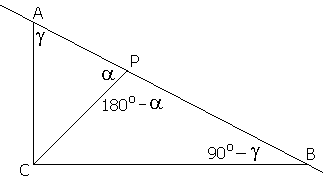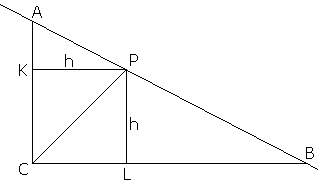Point on Bisector in Right Angle
A straight line drawn through point P on the bisector of a right angle, intercepts on the sides of the angle segments of lengths a and b. Prove that the sum
|Contact| |Front page| |Content| |Geometry|
Copyright © 1996-2018 Alexander Bogomolny
A straight line drawn through point P on the bisector of a right angle, intercepts on the sides of the angle segments of lengths a and b. Prove that the sum
The statement is quite simple. We'll give two proofs, trigonometric and synthetic.
Let the right angle be C and the line through point P intersect the sides of the angle in points A and B so that
Proof 1

Introduce α = ∠CPA and γ = &CAP. In ΔACP, by the law of sines
sinγ/CP = sinα/b.
In ΔBCP, sin(∠CBP) = sin(90° - γ) = cosγ and sin(∠BPC) = sin(180° - α) = sinα. By the law of sines,
cosγ/CP = sinα/a.
It follows that
1/a + 1/b = (sinγ + cosγ)/sinα/CP.
In ΔACP, α + γ = 135°. Since sin(135°) = -cos(135°) = √2/2, we obtain by the addition/subtraction formulas for sine
sinα = sin(135° - γ) = √2/2(sinγ + cosγ),
from which
1/a + 1/b = √2/CP,
independent of either γ or α.
The expression CP/√2 relates a diagonal of a square to its side. This suggests
Proof 2

Drop perpendiculars KP and LP from P to the sides AC and BC, respectively. Since CP is the angle bisector of the right angle ACB, CKPL is a square. Let its side be h. Triangles AKP and PLB are similar, leading to a proportion
AK/KP = LP/BL or (b - h) / h = h / (a - h),
which we modify to
ab - h(a + b) + h² = h²,
and next to
ab = h(a + b).
This, after the division by abh, yields the required
1/a + 1/b = 1/h,
with h only dependent on the position of point P on the angle bisector.
References
|Contact| |Front page| |Content| |Geometry|
Copyright © 1996-2018 Alexander Bogomolny
73572514
